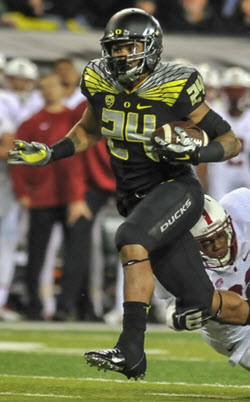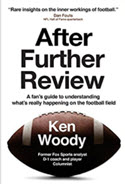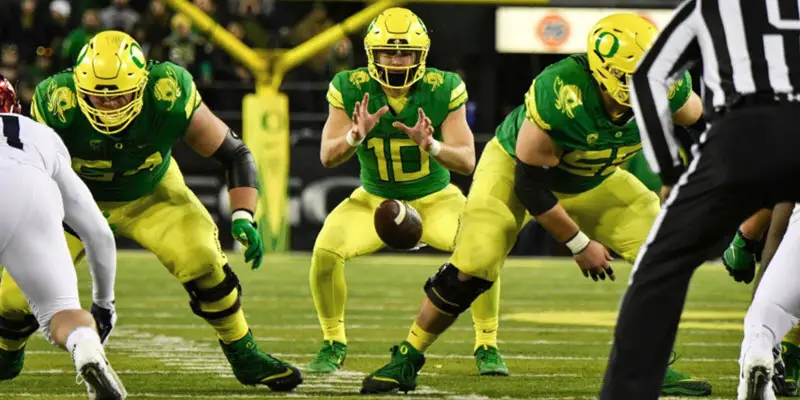In one of the most complete games played by an Oregon defense in years, Jim Leavitt’s defensive unit put the kybosh on the most explosive player and team in the Pac-12, and Duck quarterback Justin Herbert returned to action prompting a surge of adrenaline that awoke a somnolent offense for a 48-28 Dad’s Day win over Arizona.
The win gave first-year coach Willie Taggart a chance at a winning season in his first year as the head Duck, and also made Oregon bowl eligible, something that looked doubtful after three straight losses in October. The victory came after a much-needed bye week that allowed Herbert to heal and the defense to get back to fundamentals that they demonstrated the entire game against the Wildcats.
The Duck defense (above) wasted no time in establishing the perimeter control and discipline necessary to contain Khalil Tate, Arizona’s quarterback, who was averaging 160 yards per game rushing coming into Autzen. In the example above, Oregon’s right outside linebacker has his outside foot back and keeps his outside arm free, the better to maintain his angle and leverage on Tate.
Because the linebacker is outside and in front of him, Tate cannot get to the outside and instead is turned back towards the rest of the defense, square to their gap responsibilities, with their pad levels low, their eyes up and zeroing in on Tate. The left outside linebacker is square to the quarterback, maintaining a leverage position on Tate from the other side, should he try and make a run for it as he’s done so many times this season.
In this example, (above) Tate is once-again stymied by the contain of the outside linebacker, Jonah Moi (3), who has perfect position, keeping Tate inside and in front of him. Notice that the Duck defensive linemen occupy the Wildcat’s offensive linemen, allowing the inside linebackers to remain free of blockers and make the tackle. This is precisely the way a good 3-4 defense is supposed to work.
Notice (above) in particular the low pad level of Oregon’s defensive linemen, how quickly they are reacting to the snap of the ball and using their hands to control Arizona’s blockers. As the ball carrier is tackled, there are seven defenders closing in, an excellent example of the pursuit the Ducks showed throughout the entire game, holding Tate to only 32 yards rushing with the longest 13 yards.
The offensive line vowed to protect Herbert when he dropped back to pass as this example above shows, giving him “all day to throw” this touchdown to tight end Jacob Breeland.
Oregon’s right guard (above) demonstrates the use of vision in securing his initial gap blocking responsibility and helps out his right tackle and then center, to help secure the pocket. The linemen’s pad level, stance and balance are excellent as they show the coordinated teamwork necessary for protecting the passer. Arizona was only able to sack Herbert once.
Watch the nose guard, Jordon Scott (34), as he explodes on the snap, slants to his right and drives the left guard into the backfield, and into two other blockers. This disrupts the handoff and forces the running back to lose ground directly into three defenders who are unblocked because of Scott’s sacrifice.
This is the job of the nose guard (above) in a 3-4 defense: penetrate and tie up blockers. Scott is on the short side (6-1), but he weighs 333 and is quick and bull strong—not bad for a true freshman. The defense had a blitz coming from their left side and Arizona was again squeezed into the middle of the defense from both sides.
Fans wondering about the differences Taggart would instill with his “Gulf Coast” offense got a close up on this play: perfect blocking on Royce Freeman’s second of four touchdown runs. Tyrell Crosby (73), left tackle, blocks down and seals the inside running lane, while right guard Calvin Throckmorton (54), pulls and kicks out the end defender on the line of scrimmage, opening a hole for Freeman to follow H-back Jacob Breeland, who seals the linebacker and allows Freeman to score, untouched.
The fake to Charles Nelson on the sweep to the right is important because it freezes the inside linebackers who must react one way if Nelson gets the ball and another if Freeman gets the ball going the other way. The freeze may only be a split second, but it allows the pulling blockers to get a head start on the linebackers and establish good blocking angles.

Thomas Tyner will be wearing “Beaver Black” in this Civil War.
In a way, this play reminds me of the great old power sweep Vince Lombardi’s Green Bay Packers ran to methodical perfection. It could be a further challenge for the defense after all this action in the backfield if Herbert threw a play-action pass against defenders hustling to stop what they think is a two-way running play.
Civil War: How Much Heart do the Beavers Still Have?
Oregon State’s defense has taken heat from opponents on the field and from ex-coach Gary Anderson, who bailed early in the season, and temporary head coach Cory Hall, who have criticized both players and assistant coaches for the Beaver’s shoddy state. Because this is a hotly contested rival game that is often decided by the toughest team with the biggest heart that day, don’t discount the human spirit.
It doesn’t matter what happened before the Civil War: all the stats, success and un-success stories are out the window. The Ducks are flying high at the moment; Beaver Nation is in disarray—a perfect setting for a surprise and possibly, an upset? Probably not, but experience tells me Oregon needs to play with the same focus and discipline they showed against Arizona. It’s going to be a good habit to get into if you want to become a contender.
Retired College Coach Ken Woody
Eugene, Oregon
Top Photo: Eugene Johnson
Ken Woody is a former Fox Sports football commentator who played defensive back, receiver and kicker for Oregon from 1966 to 1970. He coached college football for 18 years, including stints as an assistant coach at Oregon, Washington, Washington State and Utah State, and was head coach at Whitman College and Washington University-St. Louis.
 Buy the book to learn from Coach Woody, or give a gift of football.
Buy the book to learn from Coach Woody, or give a gift of football.
“Every Oregon fan should have a copy to learn from as I do.” Charles Fischer
Related Articles:
“I learned football working under many great coaches, among them Len Casanova, Jerry Frei, John Robinson, Bruce Snyder, George Seifert,and Ron Stratten at the University of Oregon, Jim Owens at the University of Washington and Jim Walden at Washington State University. Most of my coaching experience was on the offensive side of the ball with quarterbacks, receivers and kickers although as a head coach I coached defensive backs, linebackers and offensive line.
I achieved my first goal of being the youngest head coach in college football at the age of 26 and throughout my career in coaching and outside of it, as a journalist and broadcaster, have experienced how exciting and gratifying it is teaching the game to others.”

